
for
- Python
for문의 주의점- Python은 한번의 Cycle이후, 기준이 변경된지 모름 (-_-);!!
- C
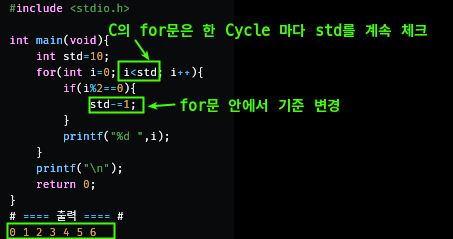
- Python:
for의 진행, 비진행 standard의 dynamic 변경을 눈치 채지 못한다.

- Solution!
- 그래서 필자는 그냥 아래처럼 쓴다.

- 그래서 필자는 그냥 아래처럼 쓴다.
range
i=0; i<10; i++
for i in range(10): # for(int i=0 ; i<10 ; i++)
print(i) # i=0, 1, 2, 3, 4, 5, 6, 7, 8, 9
for i in range(0,10):
print(i)i=5; i<10; i++
for i in range(5, 10): # for(i=5 ; i< 10; i++)
print(i) # i=5, 6, 7, 8, 9 i=10, i>0; i--
for i in range(10, 0, -1):
print(i)
--- 출력 ---
10
9
8
7
6
5
4
3
2
1
for idx,val in enumerate( )
arr=[1,2,3,4,5]
for idx,val in enumerate(arr):
print(idx, val)
generator, yield
- generator는 iterator와 같은 loop를 컨트롤하기 위해 쓰여지는 특별한 함수이다.
- yield는 한 번 호출될 때, 한번의 return
- 결국 generator, yield를 잘 사용하면 memory 절약
- 특히
for문에서 반복문 때, 위처럼in range를 사용한다. 하지만,range(0,100)과 같은 경우100 size의 list를 만든다. 이는 분명 의미 없는 메모리 낭비 이다.
- 특히
- 수 많은 자료를 돌아다니면서, 반복문을 돌려야하면
Generator를 사용하자.


yield
- yield는 함수 실행 중간에 빠져 나올 수 있는 generator를 만들 때, 사용한다.
- yield ≒ return 이라고 생각하자!!
- 하지만 return은 아예, StopIteration Exception을 만들어 빠져나오지만,
yield는 잠시 대기한다. yield도 iterator를 다돌면, StopIteration Exception

gen을 사용한 for문
# 1.
def gen_func(nums):
for i in nums:
yield i * i
for i in gen_func([1,2,3,4,5]):
print(i)
-----
# 2.
gen_list = (x*x for x in [1,2,3,4,5]) # not [x*x for x in [1,2,3,4,5]]
for i in gen_list:
print(i)
# 1.
def gen_func(nums):
for i in nums:
yield i * i
arr = [1,2,3,4,5]
for i in gen_func(arr):
print(i)
-------
# 2.
arr = [1,2,3,4,5]
gen_list = (x*x for x in arr)
for i in gen_list:
print(i)
-------
# 3.
arr = (x for x in range(100))
print(arr) ==> generator<0x100000>
next(arr) ====> 0
while
a = []
print(a) # false
i =0
while True:
if not a:
break
print(a[i])
i+=1이터레이터 제어

concurrent: 코루틴
- subroutine
- main에서 호출 -> subroutine 에서 수행(흐름제어)
- 코루틴(Coroutine)
yield로 main과 subroutine이 왔다갔다.- 루틴 실행 중 중지 -> concurrency
- 장점: 쓰레드에 비해 오버헤드 감소
- 멀티 쓰레드가 너무 복잡하고, 교착 상태, 컨텍스트 스위칭 비용 발생 하니까 코루틴으로 변경되는 추세

 yield 에서 멈춰있는데, 또 next() 를 호출하면 yield는
yield 에서 멈춰있는데, 또 next() 를 호출하면 yield는 None반환
send
send()를 사용해 main 루틴에서 yield 로 전달 가능

coroutine 상태
GEN_CREATED: 처음 대기 상태GEN_RUNNING: 실행 상태GEN_SUSPENDED:yield대기 상태GEN_CLOSED: 실행 완료 상태
async, await
- Python 3
>=3.5
- def => async
- yield => await
Async I/O
- 동기, 비동기는 Sync/Async/Block/Non-Block 글 참고
- Non Block상태: caller가 어떤 함수를 call 했는데 callee 도 thread 등으로 자체 제어권을 가지고 있어서,
caller가 자기 제어권으로 계속 일을 수행함
- Non Block상태: caller가 어떤 함수를 call 했는데 callee 도 thread 등으로 자체 제어권을 가지고 있어서,
- callee가 결과 값을 주던 안주던~~ 제어권을 각자가지고 있음
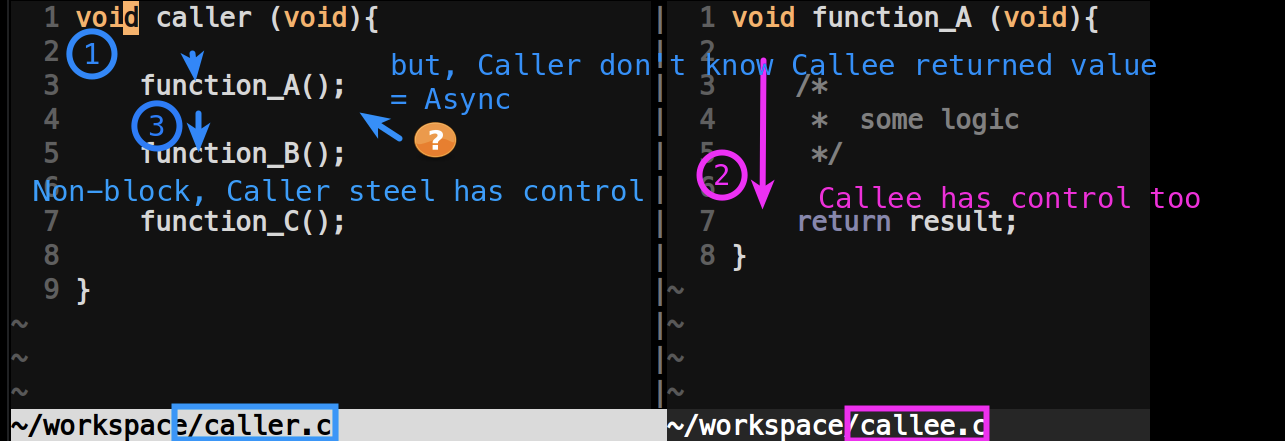
- 하지만, callee와 값이 Sync 되지 않았다면 Async!
- callee는 일을 다하면, caller에게 이를 알리면 sync 됨
Async I/O의 종류
- 연산 중심의 비동기 함수
- I/O 중심의 비동기 함수
2.1 File I/O: 디스크로 부터 파일을 읽어 RAM에 올리는 걸 CPU명령이 기다리면, 비효율 끝판왕
pip asyncio 설치
$ python3 -m pip install asyncio
$ python3 -m pip install beautifulsoup4asyncio: async, await의 syntax를 사용한 비동기 IO를 위한 library- coroutine 에서, network나 파일 I/O를 위해 따로 High-level로 만든 것이,
asyncio
asyncio 사용
1. future 객체리스트 내 블록킹 함수를 사용해도, Non-block IO
await (= yield) 'Non-block 하고픈 함수 사용'


import asyncio
from urllib.request import urlopen
from concurrent.futures import ThreadPoolExecutor
import threading
urls = ['https://naver.com', 'http://daum.net']
async def fetch(url, executor):
# 스레드명 출력
print('Thread Name : ', threading.current_thread().getName(), 'Start', url)
# 실행
res = await loop.run_in_executor(executor, urlopen, url) # loop는 main에서 선언했기때문에 참조할 수 있다.
print('Thread Name : ', threading.current_thread().getName(), 'Done', url)
# 결과 반환
return res.read()
async def main():
# async: 나는 비 동기 함수야!
# 스레드 풀 생성
executor = ThreadPoolExecutor(max_workers=10)
# future 객체 모아서 gather에서 실행
futures = [
asyncio.ensure_future(fetch(url,executor)) for url in urls # 실행할 함수를 쌍으로 넣으면된다. # 각 사이트에 각 스레드가 실행된다.
]
# 결과 취함
res = await asyncio.gather(*futures) # futures가 끝날때까지 기다린다. (*는 그냥 unpacking)
print('Result : ', res)
if __name__ == '__main__':
loop = asyncio.get_event_loop() # 루프 초기화
loop.run_until_complete(main()) # 작업완료까지 대기. 끝날 때 까지 이 루프는 계속된다.
1-1. beautifulsoup4 사용해서, html에 원하는 Tag 찾기
$ pip3 install beautifulsoup4- import
from bs4 import Beautifulsoup4
1. sync 및 blocking 작업 예

getpage(x)마다 동기 및 blocking 함수 이기 때문에, 5초 소요
2. async 및 non-blocking 작업 예
 최종적으로
최종적으로 1.0x초 소요
#!/usr/bin/env python3
import time
import asyncio
async def getpage(url):
s=time.time()
await asyncio.sleep(1) # Bg 대기
print('%d' % (url))
e=time.time()
print(e-s)
async def main():
await asyncio.gather(
getpage(1),
getpage(2),
getpage(3),
getpage(4),
getpage(5)
)
loop=asyncio.get_event_loop()
loop.run_until_complete(main())
loop.close()3. sync 및 blocking get URL
- requests 모듈: url로 부터 text, html src를 받을 수 있음
- 모듈 설치:
$ pip3 install requests - requests.get(url)은 Blocking 함수
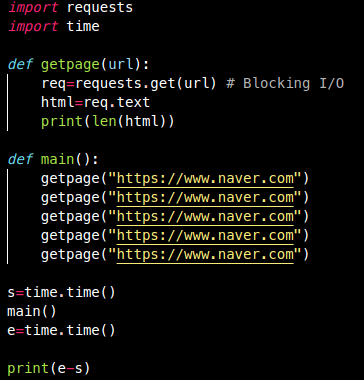
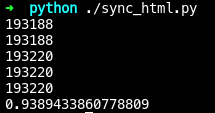
약0.94초 소요
- 모듈 설치:
4. async 및 non-blocking get URL
 약
약 0.21초 소요- loop.run_in_executor(): sync함수 -> async
#!/usr/bin/env python3
import requests
import asyncio
import time
async def getpage(url):
req=await loop.run_in_executor(None, requests.get, url)
html=req.text
print(len(html))
async def main():
await asyncio.gather(
getpage("https://www.naver.com"),
getpage("https://www.naver.com"),
getpage("https://www.naver.com"),
getpage("https://www.naver.com"),
getpage("https://www.naver.com")
)
s=time.time()
loop=asyncio.get_event_loop()
loop.run_until_complete(main())
loop.close()
e=time.time()
print(e-s)
async subprocess
예제 1.
import asyncio
async def run(cmd):
proc = await asyncio.create_subprocess_shell(
cmd,
stdout=asyncio.subprocess.PIPE,
stderr=asyncio.subprocess.PIPE)
stdout, stderr = await proc.communicate()
print(f'[{cmd!r} exited with {proc.returncode}]')
if stdout:
print(f'[stdout]\n{stdout.decode()}')
if stderr:
print(f'[stderr]\n{stderr.decode()}')
if __name__ == '__main__':
asyncio.run(run('echo helloworld'))
# === 출력 ===
['echo helloworld' exited with 0]
[stdout]
helloworld
예제 2. 2개의 async subprocess
- 모든
asyncio서브프로세스 함수는 비동기 이고,asyncio가 이러한 함수로 작업 할 수 있는 많은 도구를 제공한다. - 여러 명령 동시 실행은 아래처럼 한다.
import asyncio
async def run(cmd):
proc = await asyncio.create_subprocess_shell(
cmd,
stdout=asyncio.subprocess.PIPE,
stderr=asyncio.subprocess.PIPE)
stdout, stderr = await proc.communicate()
print(f'[{cmd!r} exited with {proc.returncode}]')
if stdout:
print(f'[stdout]\n{stdout.decode()}')
if stderr:
print(f'[stderr]\n{stderr.decode()}')
async def async_main():
await asyncio.gather(
run('ls'),
run('sleep 1; echo "hello"')
)
if __name__ == '__main__':
asyncio.run(async_main())
- 결과
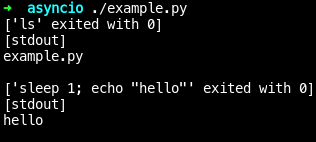
서브프로세스 만들기
coroutine asyncio.create_subprocess_exec(program, *args, stdin=None, stdout=None, stderr=None, limit=None, **kwds)주의 Deprecated since version 3.8, removed in version 3.10: The loop parameter.
coroutine asyncio.create_subprocess_shell(cmd, stdin=None, stdout=None, stderr=None, limit=None, **kwds)
| argument | description |
|---|---|
cmd | 셸 명령을 실행한다. |
limit | Process.stdout과 Process.stderr에 대한 StreamReader 래퍼의 버퍼 한계 설정 |
| return | description |
|---|---|
| Process 인스턴스 | 성공 |
concurrent.futures
- Python 3
>= 3.2 - 비동기 실행을 위한 API를 고수준으로 작성 -> 사용하기 쉽도록 개선
GIL
- Python만의 독특한, 글로벌 인터프린터 lock
- 두 개 이상의 스레드가 동시에 실행될 때, 하나의 자원을 액세스하는 경우 문제점 방지하기 위해, GIL이 실행된다.
- GIL 실행, 리소스 전체에 Lock -> Context Switch 비용.. 때문에 오히려 싱글스레드보다 느려질 수 있다.
- GIL 우회법은 주로,
multiprocess,CPython
사용
from concurrent import futures

#!/usr/bin/env python3
from concurrent import futures
WORK_LIST = [10**3, 10**4, 10**5]
def sum_gen(n):
return sum(n for n in range(1, n+1))
if __name__ == '__main__':
with futures.ThreadPoolExecutor() as executor:
result = executor.map(sum_gen, WORK_LIST)
print(*result)Scheduling

#!/usr/bin/env python3
from concurrent import futures
WORK_LIST = [10**3, 10**4, 10**5]
def sum_gen(n):
return sum(n for n in range(1, n+1))
if __name__ == '__main__':
futures_list = []
with futures.ThreadPoolExecutor() as executor:
for work in WORK_LIST:
future = executor.submit(sum_gen, work)
futures_list.append(future)
print('Scheduling for {} : {}'.format(work,future))wait

#!/usr/bin/env python3
from concurrent.futures import ThreadPoolExecutor, ProcessPoolExecutor, wait, as_completed
WORK_LIST = [10**7, 10**4, 10**5]
def sum_gen(n):
return sum(n for n in range(1, n+1))
if __name__ == '__main__':
futures_list = []
with ThreadPoolExecutor() as executor:
for work in WORK_LIST:
future = executor.submit(sum_gen, work)
futures_list.append(future)
print('Scheduling for {} : {}'.format(work,future))
result = wait(futures_list, timeout=0.00000001)
print('Completed Tasks: ' + str(result.done))
print('Completed Tasks: ' + str(result.not_done))결과 출력
as_completed







